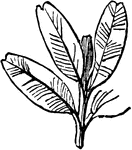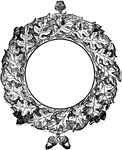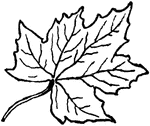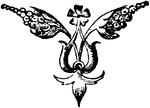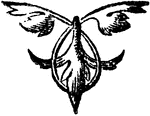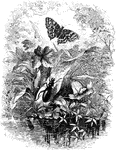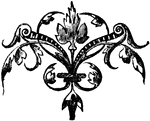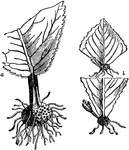
Leaf Cuttings
Plant propagation is the process of artificially or naturally distributing plants. Pictured here is…
Disk-floret of the Senecio
An illustration of a disk-floret of the senecio flower. Senecio is a genus of the daisy family (Asteraceae)…

Disk-floret of the Senecio (Longitudinal Section)
An longitudinal section view of a disk-floret of the senecio flower. Senecio is a genus of the daisy…

Female ray-floret of the Senecio
An illustration of a ray-floret of the senecio flower. Senecio is a genus of the daisy family (Asteraceae)…
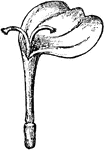
Gynaeceum of the Senecio
An illustration of the gynaeceum of the senecio flower. Senecio is a genus of the daisy family (Asteraceae)…
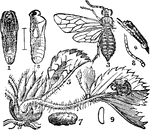
Strawberry Sawfly
"Strawberry False-worm (Emphytus maculatus). 1, 2 pupa, ventral and lateral views (line shows natural…

Plantain Flower and Bract
An illustration of a plantain plant flower and bract. In botany, a bract is a modified or specialized…
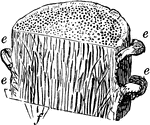
Palm Stem
Section of the stem from a palm tree, showing how endogens grow threw elongation internally. "1. Section…
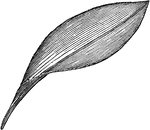
Endogenous Leaf
The image shows how endogens grow threw elongation internally. "Endogenous leaf, showing its parallel…

Epiphyllospermous Frond
"Part of Epiphyllospermous Frond. In botany, bearing the fruit or spores on the back of the leaves or…
Adderstongue
Lphioglossum (adder's-tongue) is a genus of about 25-30 species of Ophioglossales in the family Ophioglossaceae,…

Flower of a Moss
An illustration of the flower of a moss: ar, archegonium; an, antheridium; p, paraphysis; bl, leaf.

Coca Leaf
The leaf of the coca plant (Erythroxylon coca) best known for its use in the drug cocaine.

Duckweed
Common duckweed, Lemna. The entire plant is reduced to a leaf-like expansion which bears a…

Arrowhead
A leaf of arrowhead (Sagittaria), a member of the water-plantain family, growing abundantly…
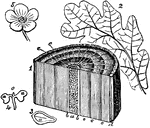
Section of Branch Showing Exogen
"Exogen. 1. Section of a branch of three years' growth: a, medulla or pith; b b, medullary sheath; e…
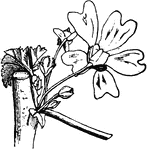
Fascicle of Mallow Flowers
The image shows a fascicle (bundle or cluster) of flowers of a mallow plant (Malvaceae).

Fiddle-Shaped Leaf
A leaf which has "the form of a fiddle or violin; pandurate or panduriform: applied in botany to an…
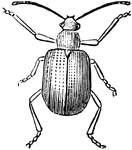
Grape Rootworm Beetle
The Grape Rootworm Beetle (Fidia viticida) is an insect in the Chrysomelidae family of leaf beetles.

Grapevine Flea Beetle
The Grapevine Flea Beetle (Altica chalybea). "a, leaf infested with larvae; b, larva; c, cocoon; d,…

Fly Book for Fishing
"A case in the form of a book in which to keep fishing-flies. It has leaves of Bristol-board or other…

Tracery Foliations
The tracery on the windows of La Sainte-Chapelle, in Paris, France shows foliations: a leaf pattern…

Scab Fungus
"The Scab-fungus (Venturia inaequalis). a, an infested apple, showing scabs caused by the fungus; b,…
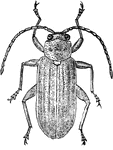
Dorsal View of Leaf Beetle
Galeruca notata is a beetle species in the Chrysomelidae family of leaf beetles.
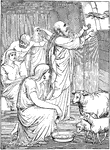
Return of the Dove to the Ark
"And the dove came in to him in the evening; and, lo, in her mouth was an olive leaf pluckt off: so…
Floating Foxtail Grass
The Floating Foxtail (Alopecurus geniculatus) has a stem ascending, bent, and forming knees at the lower…

Floating Foxtail Grass
The Floating Foxtail (Alopecurus geniculatus) has a stem ascending, bent, and forming knees at the lower…

Wood Meadow Grass
Wood Meadow Grass (Poa nemoralis) grows from eighteen inches to two feet high. It has a perennial, creeping…

Wood Meadow Grass
Wood Meadow Grass (Poa nemoralis) grows from eighteen inches to two feet high. It has a perennial, creeping…

June Grass
June grass (Poa prstensis) is also known as Green Meadow grass, Common Spear Grass, Kentucky Blue grass.…

June Grass
June grass (Poa prstensis) is also known as Green Meadow grass, Common Spear Grass, Kentucky Blue grass.…
Meadow Soft Grass
The Meadow Soft Grass (Holcus lanatus), also referred to as Velvet Grass, has its spikelets crowded…

Red Clover
Red Clover (Trifolium pratense) is a species of clover. The Red Clover can readily be distinguished…
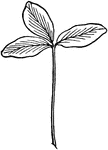
Red Clover
Red Clover (Trifolium pratense) is a species of clover. The Red Clover can readily be distinguished,…

Red Clover
Red Clover (Trifolium pratense) is a species of clover. The Red Clover can readily be distinguished…

White Clover
The White Clover ((Trifolium repens) stems are spreading, slender and creeping. The leaves are are inversely…

White Clover
The White Clover ((Trifolium repens) stems are spreading, slender and creeping. The leaves are are inversely…

Lucerne or Alfalfa Plant
Alfalfa or Lucerne (Medicago sativa) is a flowering plant in the pea family Fabaceae cultivated as an…

Lucerne or Alfalfa Plant
Alfalfa or Lucerne (Medicago sativa) is a flowering plant in the pea family Fabaceae cultivated as an…
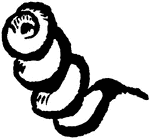
Lucerne or Alfalfa Plant
Alfalfa or Lucerne (Medicago sativa) is a flowering plant in the pea family Fabaceae cultivated as an…
Flatworm
Flatworms are flattened, leaf-like forms living in damp places on land, in freshwater streams of ponds,…
Flatworm
Flatworms are flattened, leaf-like forms living in damp places on land, in freshwater streams of ponds,…

Flatworm
Flatworms are flattened, leaf-like forms living in damp places on land, in freshwater streams of ponds,…
Flatworm
Flatworms are flattened, leaf-like forms living in damp places on land, in freshwater streams of ponds,…
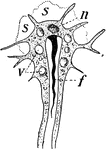
Flatworm
Flatworms are flattened, leaf-like forms living in damp places on land, in freshwater streams of ponds,…
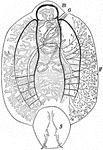
Flatworm
Flatworms are flattened, leaf-like forms living in damp places on land, in freshwater streams of ponds,…
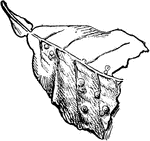
Scale Insects
The scale insects are small insects of the order Hemiptera, generally classified as the superfamily…
